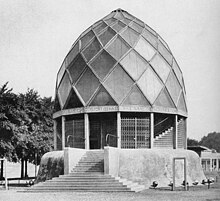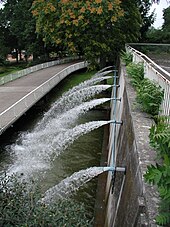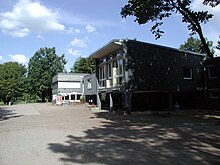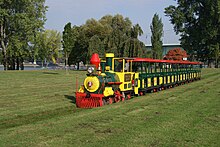Rheinpark (Cologne)


The Rheinpark is a recreational area in Cologne on the right bank of the Rhine between the Deutz and Mülheim districts . The park, with its varied history is since 1989 under monument protection .
history
The park in Prussian times
The razing of the inner fortress ring turned the militarily useless areas of these facilities into wasteland . In the Deutz area, work began in 1907 to convert such areas into urban “green”. The basis was a contract between the city of Cologne and the Reich Military Treasury dated December 14, 1907, which dealt with the acquisition of fortifications. The area around the bastion on Helenenwall, the area of a lunette at the Jewish cemetery and the area around Fort XII (later called Fort XV) in the Deutz Rheinaue , located in the later Rheinpark, resulted in a wide strip of land between the Mülheim harbor and the Hohenzollern Bridge with an unobstructed view of Cologne's old town . This was converted into a landscape park, which is now part of Cologne's green belt .
On the occasion of the twenty-five year anniversary of the enthronement of Emperor Wilhelm , a first park was created until 1913 under Lord Mayor Max Wallraf (member of the 1st Chamber (mansion) ), based on a design by Cologne gardening director Fritz Encke . This should be named in honor of the German ruler "Kaiser Wilhelm Park", but its naming was prevented by the outbreak of the First World War .
Werkbund exhibition and consequences of the war
On the occasion of the Cologne Werkbund exhibition in 1914, the park offered a number of attractions by well-known architects and artists. For example, the “glass house” by Bruno Taut , or a “factory” by Walter Gropius and a theater by Henry van de Velde . In contrast to these sights, which were only built for the time of the exhibition, the tea house designed by Wilhelm Kreis in the classicist style on the site of the abandoned fortress core work was built on a permanent basis. The building, demolished in 1957, was surrounded by the moat that was preserved and designed by Encke into a perennial garden , as well as by the old trees of the former fortress.
With the outbreak of the First World War in August 1914, the exhibition ended prematurely. The outcome of the war initially ended the further development of the park area, which with its exhibition buildings had been confiscated by the military soon after the outbreak of war. Some of the buildings fell into disrepair and were demolished. In the post-war period, the area with the remaining buildings was seized by English occupation troops until they withdrew after a flood in 1920 had destroyed many things. Only a few houses remained, including 13 buildings from the so-called "Lower Rhine Village" from the Werkbund exhibition (in later years the buildings were used by the garden administration for the creation and storage of the model landscapes made by the planning department under Nussbaum) and the one subsequently named "Parking garage", tea house lined with old poplars . From 1920 until his retirement in 1926, Encke rebuilt the Volkspark , now known for the first time as the “Rheinpark” .
Further development
The site of the Werkbund exhibition was connected to an amusement park north of the Hohenzollern Bridge, with a sports stadium behind it, on which the British troops had set up accommodation and stables. After their departure, the first buildings of the Cologne trade fair were erected there between 1922 and 1924 at the endeavors of Mayor Konrad Adenauer .
These buildings were for their little sophisticated architecture based on the former buildings of the British cavalry units from the popularly called "Adenauer's stables." In the following years, with a view to the planned further large exhibitions under Adolf Abel, a uniform perimeter development with a tower was designed and completed by the opening of the Pressa in 1928. This northern peripheral development of the park, between Auenweg and the banks of the Rhine, with the semicircle of the “State House” and the Rheinhallen with its landmark Messeturm form the entrance area of the Rheinpark today.
Encke, who had further developed the “Volkspark” until 1926, managed to preserve this recreational area close to the city for the population despite noticeable desires from industry and the Cologne trade fair by using his influence on political decision-makers.
International press exhibition
The Pressa was an international exhibition of the entire press, which took place on the initiative of Konrad Adenauer in 1928. The designs for the Pressa, with rose garden and sunbathing lawns, as well as the design of the exhibition facilities were developed by garden technician and construction director Theodor Nussbaum .
- Rhine terraces
In addition to the semicircle of the “State House” built especially for the foreign press, the “Rheinterrassen” restaurant, designed in the same brick style, was also completed for the upcoming “Pressa”. While glass (Taut's glass pavilion) was an experimental building material for the Werkbund exhibition , the asymmetrical structure had generously glazed fronts on the park side. Pointed terraces extended on the Rhine side. The Rhine terraces were designed by Adolf Abel, who had been the head of the Cologne Building Department since 1925, and by the architect Paul Bonatz . The building was modernized in 1957 by Hans Schilling .
Federal horticultural shows
BUGA 1957
At the end of 1953, Cologne was the third city to be awarded the contract to hold a Federal Garden Show , which then took place in Cologne in 1957. The Rheinpark was the main exhibition area for this federal horticultural show.
Much of the buildings erected for the Federal Garden Show have been preserved, such as a small pond behind the rose garden , which was named "Adenauerweiher" based on Adenauer's hobby , rose growing . The garden architect Theo Breddermann built a total of 14 wells made of sandstone slabs and pebble material, ten of which were arranged in circular paved hollows in the well garden . These fountains, equipped with fountains , were lit up at nightfall. Despite a restoration in 1998, the ensemble was without function for a long time. It was only through the initiative of the garden architect's niece and nephew and their support association Brunnengarten im Rheinpark, founded in 2011, as well as with the help of the city, which renovated the technology and others, that ten fountains could be put back into operation in spring 2012. The four large fountains followed by October 2014. In addition to the variety of ornamental fountains installed in the area, the “water garden” with fountain courtyard was and is a central area and attraction of the park.
Josef Jaekel built an artificial waterfall that fell from a height from a terrace wall clad with travertine slabs. The effect was created by seven mighty nozzles embedded in the wall and framed by metal wings , the discharged amounts of water falling into a first collecting basin. From there, the water flowed under a pedestrian bridge in several inclines into a larger basin. The asymmetrically designed system, which tapers flat towards the south, also had several nozzles installed in the area of the widening basin, which, as was popular in the 1950s , emitted their fountains horizontally over the water surface. The bank areas of the basin extensions had partly separated basin areas provided with aquatic plants or where there was no path adjacent to the side borders with reed beds .
The Cologne cable car crossing the Rhine was also preserved from the 1957 Federal Horticultural Show . The park railway, on the other hand, was dismantled and the chairlift leading across the park was demolished in 2003, after it had not been in operation for years. The park railway, which still operates today, was built - on the route of the railway from 1957 - with the Federal Horticultural Show in 1971.
BUGA 1971
The grounds of the Rheinpark were again part of a federal horticultural show in 1971 after a larger plan for it on the southern outskirts of Cologne's inner city had failed due to excessive costs. In addition to the exhibition space in the Rheinpark, this federal horticultural show also took place in the Riehler Aue .
Much of the design of the BUGA 1957 has been preserved and renovated. In addition, there were also new systems that were retained beyond the duration of the exhibition. This includes the “Mediterranean Garden” designed by the Israeli artist Walter Polak in the southeastern area of the park (behind the State House). Various water features are focal points and points of attraction for visitors to the Mediterranean Garden area. The “play hill landscape” in the center of the park also comes from BUGA 71, as do other modern sculptures presented in the park . In keeping with the taste of the times, it was the works of a new generation whose objects, such as those by Otto Piene (wind sculptures), François Baschet , Alexander Sarda and Anton Berger (kinetic metal objects), only come to their full potential in the great outdoors in interaction with wind and water Development come. Some of the works of art erected in 1957 had meanwhile been given new locations in museums or in other urban green spaces. A bronze by the sculptor Fritz Behn , Diana with a jumping antelope , is now on the Sachsenring .
Works of art
Contemporary sculptures were brought into the Rheinpark for both federal horticultural shows. In 1957 the Wallraf-Richartz-Museum under Leopold Reidemeister made a large number of works of art from the years 1875 to 1956 available. These were partially preserved in the park, but also changed their location when the following changes were made.
- Bronze statue Gaea (1965) by Gerhard Marcks in the rose garden, (a variation of Gaea II, half-covered (2005), is in the Stollwerkpassage on Hohe Straße ).
- Bronze statue Eva II by Gerhard Marcks
- Bronze statue of domestic worries (1913), wife and model (Nel) by the Belgian painter and sculptor Rik Wouters , purchased in 1956 by the Art Association for the Rhineland and Westphalia for the BUGA from the Royal Museums of Fine Arts in Brussels .
- Seated by Kurt Lehmann (1905 to 2000)
- Kurt Lehmann's children's group , created 1952/53
- Schreitender by Richard Scheibe (1879 to 1964), created 1952
- Rotating compass rose by François Baschet and Bernard Baschet, see also: Cristal Baschet
- Hedgehog with a snake by Fritz Bermuth (1904 to 1979)
- Two storks by Philipp Harth (1887 to 1968)
- Assunta by Georg Kolbe (1877 to 1947), created in 1921
- Rising Pony by Renée Sintenis (Renate Alice) (1888-1965), created in 1942
- Water ballet by Christian Weiser (1941), created in 1971
- Orchid by Alexander Sarda (1926), created in 1971
Thermal springs and bath
At the north end of the Rheinpark is the thermal bath "Claudius-Therme" right next to the zoo bridge .
In search of drinking water they found what they were looking for in a 1912 drilling in Cologne-Stammheim at a depth of 70 meters. It was, however, carbonated and chloride-rich mineral water . As a result, the thought arose that the city could become a kind of spa . As early as 1931, under Mayor Adenauer, the 251-meter-deep exhibition fountain I was drilled on the exhibition grounds. A mineral-containing water could then be pumped from this. The drilling of Messebrunnen II, however, remained meaningless in terms of its productivity. The 364 meters depth of the exhibition fountain III, which was then reached in 1961 and 1962 with better technology, then brought up to 200 m³ / h of thermal carbonated sodium chloride water. Even with a sum of half a million DM already spent , the goal of encountering a spring vein with higher water temperatures had not been achieved, so the city council had the work to develop a thermal spring stopped. However, the city administration allowed work to continue later, initially without informing the council. Around 1967 the fair fountain IV was successful with a depth of 1027 meters then great technical efforts drilled . A sodium chloride thermal bath with a temperature of 28.5 ° C has now been extracted from borehole IV. With this rather moderate value compared to other German thermal baths ( Aachen 74 ° C, Wiesbaden 66 ° C.), The minimum requirements were met.
For example, a thermal bath was opened in January 1971 in the northeast corner of the Rheinpark, on Sachsenbergstrasse, where the promoted medicinal water of a Gesundbrunnen was offered to visitors at the BUGA 1957, after three quarters of construction. In 1975 the spring was officially recognized as a healing spring, as its water contains nine other minerals in addition to table salt. The three-story building, which is under private management, burned to the ground in August 1986. The new facility built after many years at the same location, today's "Claudius-Therme", is available for its thermal operation in the Messebrunnen III and IV.
Cologne Youth Park
The planning for the Cologne Garden Show, which began in 1954, also included attractions for children and young people. The narrow northern end of the Rheinpark area intended for the exhibition was ideal for this purpose. In the middle of the big city with its increasingly built-up open spaces for the youth, a “youth park” away from the residential areas offered ideal conditions. Initiated by those responsible for Cologne's youth work, an area of around 30,000 m² was prepared north of Sachsenbergstrasse at the same time as the 1957 garden show. The center of the facility was and is a two-storey elongated structure. It was adapted to different age groups with play and sports equipment, craft rooms and reading areas and offered various event rooms of different sizes. The outdoor area received a sports field, mini golf course and a garden theater for amateur games. This open air area was also used for dance events but also as a roller skating rink and in winter as an ice rink. The site and the house were given the name “Cologne Youth Park”.
The organization of the "youth park", a youth center , sponsoring organization was from 1957 to 2000 the Kölner Jugendpark e. V., envisaged a so-called “house of the open door ” as a socio-educational concept . Since the facility was not connected to any residential area, a special national program was developed for children and young people of all ages between 10 and 25 years. In the mornings, the facilities in the house and on the premises were often used as an alternative location for teaching by vocational schools, and in the afternoons the facilities were used by self-organized youth groups or associations.
The rest of the area was deliberately left completely unstructured in order to give free rein to the young people's imagination, which is still evident today in the “high ropes course”. In the period that followed, camps and concerts were held.

There were music educational offers, BMX activities have been taking place for 23 years, there were puppet shows for the little ones, and children were able to actively participate in special circus events. The computer age also found its way into the youth park, devices and instructions are provided for Internet newbies. Since the town twinning agreement between the then Mayor Norbert Burger and his Polish colleague from the city of Katowice , there have been close relationships between the schools and youth facilities there and the "Cologne Youth Park", which has since become a regular annual exchange between young people from the two cities. In addition, the "Kölner Jugendpark" (since 2000 Jugendzentrum Köln gGmbH ) has been recognized as a "Kölner Modell" (Cologne Model) and has become a permanent institution on the grounds of the Rheinpark.
Family park
In June 2012, the more than 6000 m² family park was opened under the Zoobrücke, between the youth park and the Rhine park, funded with federal and state funding. Covered under the bridge, a mini golf course, combined street skater and BMX ler course, fenced in street soccer and street basketball fields as well as a Mincar course and at the end a free climber wall were laid out on stone slabs. Outside the “roof”, on natural ground, there are swings and trampolines installed. The design of the facility by the Kalk firm Lill und Sparla received one of four NRW landscape architecture awards from the Association of German Landscape Architects in April 2014 .
Other facilities
Dance fountain
At the Tanzbrunnen from 1957 by Josef Op Gen Oorth , spanned with a tent construction by the architect Frei Otto , with an open-air stage and partly with spectator seats again roofed over by Frei Otto in 1971, musical events take place and the well-known talent rehearsals for musical talent in front of a critical audience Offspring, introduced in 1971 by Udo Werner . It can accommodate up to 12,500 spectators.
Park railway
The first small train used on the occasion of the Pressa in 1928 traveled the route between the Deutzer Brücke and the Mülheim harbor.
For the first Federal Garden Show in 1957, a park railway was built on the approximately 2 km long circuit between “Tanzbrunnen” and “Rosengarten”, which has been maintained to this day, but was then dismantled.
The park railway that runs today was installed with the Federal Garden Show in 1971. It used the old route from 1957. Since 2001, the restored Porsche locomotive of the 1971 garden show train type has been used occasionally .
Pacifier tree
On May 16, 2007, a female and a male paper mulberry tree (Broussonetia papyrifera) were planted and inaugurated as pacifier trees .
End of parking with preserved meadow landscape
The "Jugendpark", as the northern continuation of the Rheinpark starting from the Zoobrücke, has been able to preserve most of the character of the original meadow landscape. This section between the banks of the Rhine and the area of the Mülheim harbor ends as a pointed headland . The first draft (probably by Bernhard Hermkes ) to connect the park and Mülheim with a bridge was discarded for reasons of cost. The concept suggested designing the bridge in the shape of a dragon, whereby the structure would have been a tail on the Mülheim side and the raised head on the park side should face the area on the left bank of the Rhine. The bridge construction that was then realized was the one designed by the architect Gerd Lohmer and realized in 1955 by the company Wayss & Freytag . The pedestrian bridge has a slim arch shape, which has a gradient of 15% due to the factored in shipping traffic to the port. The "Mülheim Harbor Bridge" enabled park visitors to take a direct route as an entrance or exit from Mülheim without detours. The Rheinpark and the bridge became the link of an approximately 11 kilometer long green corridor from the Poller Wiesen to the Stammheimer Schlosspark .
Award of the park
For the 50th anniversary, the park was named Germany's most beautiful park in 2007 . The award for the ten most beautiful public parks is carried out by Briggs & Stratton with an independent jury of experts . The winner takes part in the European competition. The German Federal Horticultural Association in Bonn also awarded the honorary prize for excellent and sustainable use of the park to the Rheinpark , which it awarded for the first time in 2007 , because the old splendor of the complex has almost been restored .
literature
- Joachim Bauer, Dieter Klein-Meynen, Henriette Meynen: Garden on the river, the Rheinpark in Cologne. Bachem Verlag, Cologne 2007
- Ulrich S. Soénius (Hrsg.), Jürgen Wilhelm (Hrsg.): Kölner Personen-Lexikon. Greven, Cologne 2007, ISBN 978-3-7743-0400-0 .
- Joachim Bauer and Carmen Kohls: Cologne under French and Prussian rule. In: Werner Adams, Joachim Bauer (Hrsg.): From the botanical garden to urban green - 200 years of Cologne green. (Stadtspuren - Monuments in Cologne, Volume 30) Bachem Verlag, Cologne 2001, ISBN 3-7616-1460-8
- Carl Dietmar: The Chronicle of Cologne. Chronik Verlag, Dortmund 1991, ISBN 3-611-00193-7
- Youth Centers Cologne: Cologne Youth Park 1957-2007.
- 50 years of youth work in Cologne. Published by Youth Centers Cologne gGmbH, Cologne 2007
Individual evidence
- ^ Marcus Schüller: Reconstruction and rise of the Cologne fair 1946-1956. 1999, p. 50
- ↑ Administrative report of the city of Cologne from 1921, p. 16. In: Joachim Bauer: Innerer and outer green belt. P. 158
- ↑ a b c d e f André Dumont, Alexander Hess: The Rheinpark and its history - From the fort to the Volkspark. In: Joachim Bauer, Carmen Kohls: Cologne under French and Prussian rule. In: Werner Adams, Joachim Bauer (Hrsg.): From the botanical garden to urban green - 200 years of Cologne green. (Stadtspuren - Monuments in Cologne, Volume 30), p. 2222 f.
- ^ Ulrich S. Soénius, Jürgen Wilhelm: Kölner Personen-Lexikon.
- ↑ Carl Dietmar, p. 366
- ↑ Brunnengarten Rheinpark Köln e. V. (with many photos, accessed April 2012)
- ↑ Portrait: Gerhard Marcks on http://www.kulturtussi.de/gerhard-marcks/ (accessed January 9, 2015)
- ↑ according to KStA magazine 16./17. April 2011 p. 9
- ↑ http://www.claudius-therme.de/geschichte.htm Last accessed on September 6, 2008
- ↑ Carl Dietmar, pp. 504, 543
- ^ Anniversary brochure , Cologne youth centers
- ↑ koeln-nachrichten.de of June 12, 2012
- ↑ bdla.de/NRW LA price
- ↑ koelnkongress.de, accessed in May 2010
- ↑ Kölner Stadtanzeiger from 17./18. November 2007
Web links
- Film about the Rheinpark with steam train from 1957 by koeln1.tv
- Dissertation on Rheinpark 1914 to 2005 (accessed May 2007)
Coordinates: 50 ° 56 ′ 57 ″ N , 6 ° 58 ′ 32 ″ E





























